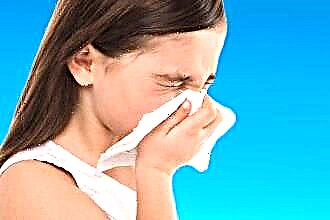The larynx is a unique organ that combines two important functions, sound reproduction, as well as carrying air from the upper respiratory tract to the lower parts, the trachea, bronchi and lungs. In this case, the glottis formed by the laryngeal ligaments is the narrowest point of the airways. An inflammatory process characterized by edema, or the development of other pathological processes localized in the vocal cords, can lead to narrowing of the gap and impaired air permeability.
Such a development of the situation serves as prerequisites for the development of a serious and dangerous condition, in which the body will not be able to receive the amount of air necessary for vital activity, laryngospasm. To develop a therapeutic tactics for such patients, it is necessary to determine what laryngospasm is and what causes it.
Causes
Laryngospasm is an involuntary contraction of muscle fibers in the larynx in response to stimuli.
 These can be pathogenic microbes, allergens, foreign bodies, chemical compounds. Thus, the causes of laryngospasm are as follows:
These can be pathogenic microbes, allergens, foreign bodies, chemical compounds. Thus, the causes of laryngospasm are as follows:
- inflammatory process in the larynx;
- exposure to an allergen;
- ingress of a foreign body into the respiratory tract;
- inhalation of hazardous substances, dust particles, chemical compounds;
- local application of certain medicinal substances;
- tumor processes localized in the neck, larynx and trachea;
- sputum flow into the larynx, which occurs with the development of nasal syndrome;
- hysterical state.
Laryngospasm is most typical for the child's body, since the anatomical structure of the child's vocal cords is characterized by a narrower glottis. In addition, due to imperfect immunity, children are more likely to get sick with acute respiratory viral infections, and, therefore, the likelihood of developing laryngospasm in childhood is higher.
Clinical signs
The main symptoms of laryngospasm are characterized by the following:
- shortness of breath while inhaling, accompanied by wheezing;
- inability to clear your throat;
- hoarse voice;
- the participation of auxiliary muscles in breathing;
- pallor of the skin, especially in the area of the nasolabial triangle;
- the appearance of cold sweats;
- possibly urination.
Depending on the action of provoking factors, laryngospasm in adults can have a fulminant, acute and chronic course.
Allergic reaction
Laryngeal spasm is characterized by a fulminant course when exposed to an allergic factor. The development of a pathological reaction may be due to a food allergen, a dangerous impurity in the inhaled air. Often, the use of drugs leads to the development of such a condition. Laryngospasm may be complicated by topical administration of drugs containing menthol or iodine.
Ammonia, often used for unconsciousness, in high concentration can also lead to reflex spasm of the muscles of the larynx and cause their spastic contraction.
The use of drugs that are allergens for a given patient can lead not only to the development of skin manifestations or rhinitis, but also a pathological reaction in the larynx. A severe manifestation of an allergic reaction is Quincke's edema, in which there is a pronounced swelling of the nose, lips, and the entire face. The larynx is also involved in the process, which can be a serious complication that requires urgent measures. If appropriate assistance is not provided, the patient may die from suffocation due to laryngeal edema and narrowing of the glottis.
Complication of inflammatory processes
Most often, the acute course of laryngospasm develops in inflammatory and infectious processes localized in the larynx. A severe course of laryngitis, characterized by pronounced edema of the vocal cords, is dangerous for the development of this complication. The main symptoms typical of laryngitis are as follows:
- violation of the timbre of the voice, the appearance of hoarseness, rapid fatigue when talking;
- dry barking cough.
With the spread of the process, the growth of edema, a qualitative change in the voice can be characterized by its absence, the development of aphonia. The cough becomes paroxysmal. Symptoms may increase due to the obstruction of air passage through the respiratory tract.
Processes localized in the nasopharynx can also lead to a narrowing of the glottis. With difficulty breathing through the nose, caused by sinusitis, rhinitis, thick discharge can drain along the back of the pharynx, closing the lumen of the glottis and causing respiratory failure. In this case, therapeutic measures should be aimed not only at stopping the spasm of the larynx, but also include therapeutic measures in the area of the nasopharynx.
True croup
Among the infectious processes that are most often the cause of the development of laryngospasm in adults, diphtheria of the oropharynx comes to the fore.  This section of the upper respiratory tract is the site of localization of the infectious process caused by diphtheria bacillus, in 95% of cases. The main symptoms are the phenomena of intoxication, as well as a pathological process localized in the throat. An obligatory sign of diphtheria is also severe sore throat.
This section of the upper respiratory tract is the site of localization of the infectious process caused by diphtheria bacillus, in 95% of cases. The main symptoms are the phenomena of intoxication, as well as a pathological process localized in the throat. An obligatory sign of diphtheria is also severe sore throat.
The pharyngoscopic picture is characterized by hyperemia and swelling of the hard and soft palate, arches, and larynx. In this case, the pathological appearance of the tonsils is characteristic. They are sharply edematous, covered with fibrinous plaque, which is removed with difficulty, leaving behind a bleeding surface. A day later, a similar film forms on this site again.
Most often, this form of diphtheria is characterized by a benign course. After a week, the symptoms of intoxication regress, pain in the throat decreases. However, objective changes in the throat persist for another week.
The course of this form of diphtheria is similar to purulent sore throat. It is often possible to clarify the diagnosis only on the basis of the results of laboratory examination. However, in some cases, diphtheria of the oropharynx transforms into a more severe, widespread form, which occurs with damage to the larynx and the possible development of laryngospasm.
Laryngeal diphtheria, in comparison with the defeat of the oropharynx, is an infrequent occurrence. The disease can be characterized by a local or widespread course, when the nasopharynx, trachea, bronchi are involved in the process. In recent years, this form of diphtheria of the larynx has become more widespread among the adult population. True croup, or laryngeal diphtheria, is dangerous for the possible development of laryngospasm in adults.
 Laryngoscopic examination, which allows to identify sharply edematous and hyperemic larynx, is of great help in diagnosing the condition. In the area of the vocal cords, characteristic fibrinous films may be present. In the process of its development, the true croup goes through three stages, each of which is characterized by an increase in the symptoms of respiratory distress.
Laryngoscopic examination, which allows to identify sharply edematous and hyperemic larynx, is of great help in diagnosing the condition. In the area of the vocal cords, characteristic fibrinous films may be present. In the process of its development, the true croup goes through three stages, each of which is characterized by an increase in the symptoms of respiratory distress.
Clinical signs of the initial (dysphonic) stage are characterized by a worsening of the condition, when a dry, rough cough intensifies and a hoarseness of the voice increases. In children, this period lasts about a day. In adults, due to their developed vocal cords, the narrowing of the respiratory gap may develop later. However, if the procedures are ineffective, in adult patients, after 5-7 days, the condition may also worsen, which will be characterized by the next, stenotic stage.
At this stage, the patient becomes restless. Shortness of breath, noisy breathing, with shortness of breath is noted. The cough becomes silent, aphonia develops. The duration of the stage is several days, during which resuscitation actions must be carried out.
The stenotic stage is an indication for such urgent measures as tracheostomy, tracheal intubation, aimed at ensuring the passage of air through the respiratory tract into the lungs.
If these actions are not taken in a timely manner, an asphyxia stage occurs, manifested by severe violations of pulmonary heart failure caused by the inability to supply oxygen to the lungs. The patient dies from suffocation.
False croup
Exposure to other infectious pathogens leads to the development of laryngeal spasm in adults much less often. The processes caused by the parainfluenza virus, measles, the causative agent of scarlet fever, rarely lead to laryngospasm. Typically, this severe complication occurs only in children.
Laryngospasm due to exposure to infectious agents is considered a false croup.
A significant role in its development is played by an excess amount of mucus that accumulates in the lining space and leads to difficulty in breathing.
As for specific pathogens, treponema pale, gonorrhea, tubercle bacillus, these processes can also be accompanied by the development of laryngeal edema. However, the pathological process develops slowly, which makes it possible for the body to adapt to conditions of lack of oxygen. Laryngospasm in adults in this situation is an atypical outcome of the disease.
Since the development of laryngospasm in adults and children can be caused by narrowing of the larynx as a result of muscle spasm, a strong emotional outburst is also a prerequisite for difficulty breathing. The condition develops at the peak of excitement. Calming actions, distracting procedures in this case will be most effective.



